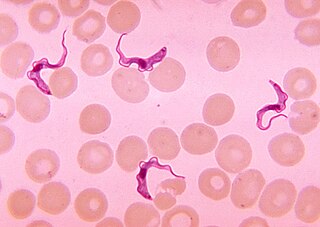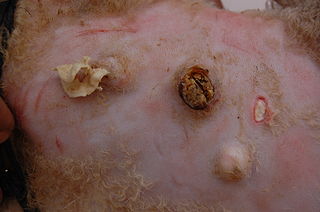
Chagas disease, also known as American trypanosomiasis, is a tropical parasitic disease caused by Trypanosoma cruzi. It is spread mostly by insects in the subfamily Triatominae, known as "kissing bugs". The symptoms change over the course of the infection. In the early stage, symptoms are typically either not present or mild, and may include fever, swollen lymph nodes, headaches, or swelling at the site of the bite. After four to eight weeks, untreated individuals enter the chronic phase of disease, which in most cases does not result in further symptoms. Up to 45% of people with chronic infections develop heart disease 10–30 years after the initial illness, which can lead to heart failure. Digestive complications, including an enlarged esophagus or an enlarged colon, may also occur in up to 21% of people, and up to 10% of people may experience nerve damage.

African trypanosomiasis, also known as African sleeping sickness or simply sleeping sickness, is an insect-borne parasitic infection of humans and other animals. It is caused by the species Trypanosoma brucei. Humans are infected by two types, Trypanosoma brucei gambiense (TbG) and Trypanosoma brucei rhodesiense (TbR). TbG causes over 98% of reported cases. Both are usually transmitted by the bite of an infected tsetse fly and are most common in rural areas.

Trypanosomiasis or trypanosomosis is the name of several diseases in vertebrates caused by parasitic protozoan trypanosomes of the genus Trypanosoma. In humans this includes African trypanosomiasis and Chagas disease. A number of other diseases occur in other animals.

Trypanosoma is a genus of kinetoplastids, a monophyletic group of unicellular parasitic flagellate protozoa. Trypanosoma is part of the phylum Sarcomastigophora. The name is derived from the Greek trypano- (borer) and soma (body) because of their corkscrew-like motion. Most trypanosomes are heteroxenous and most are transmitted via a vector. The majority of species are transmitted by blood-feeding invertebrates, but there are different mechanisms among the varying species. Some, such as Trypanosoma equiperdum, are spread by direct contact. In an invertebrate host they are generally found in the intestine, but normally occupy the bloodstream or an intracellular environment in the vertebrate host.

Trypanosoma brucei is a species of parasitic kinetoplastid belonging to the genus Trypanosoma. This parasite is the cause of vector-borne diseases of vertebrate animals, including humans, carried by species of tsetse fly in sub-Saharan Africa. In humans T. brucei causes African trypanosomiasis, or sleeping sickness. In animals it causes animal trypanosomiasis, also called nagana in cattle and horses. T. brucei has traditionally been grouped into three subspecies: T. b. brucei, T. b. gambiense and T. b. rhodesiense. The first is a parasite of non-human vertebrates, while the latter two are known to be parasites of humans. Only rarely can the T. b. brucei infect a human.

Τrypanosoma equiperdum is a species of kinetoplastid parasites that causes Dourine or covering sickness in horses and other animals in the family equidae. T. equiperdum is the only trypanosome that is not spread by an insect vector. There has been substantial controversy surrounding whether T. equiperdum should be considered a unique species, or a strain of T. evansi or T. brucei. T. equiperdum is unique in that its kinetoplast, the network of connected rings that make up its mitochondrial DNA, consists of thousands of "minicircles" that are identical in sequence.

Trypanosoma evansi is a species of excavate trypanosome in the genus Trypanosoma that causes one form of surra in animals. It has been proposed that T. evansi is—like T. equiperdum—a derivative of T. brucei. Due to this loss of part of the mitochondrial (kinetoplast) DNA T. evansi is not capable of infecting the invertebrate vector and establishing the subsequent life-stages. Due to its mechanical transmission T. evansi is not restricted to transmission via the tsetse fly but shows a very broad vector specificity including the genera Tabanus, Stomoxys, Haematopota, Chrysops and Lyperosia. It rarely causes disease in humans, indeed, it has only been recorded in cases where the patient lacks a normal component of human serum, Apolipoprotein L1. T. evansi is very common in India and Iran and causes acute disease in camels and horses, and chronic disease in cattle and buffalo. In Pakistan, it has been found to be the most prevalent trypanosome species in donkeys. Haemoglobin plays a role in trypanolytic host defense against T. evansi.

Surra is a disease of vertebrate animals. The disease is caused by protozoan trypanosomes, specifically Trypanosoma evansi, of several species which infect the blood of the vertebrate host, causing fever, weakness, and lethargy which lead to weight loss and anemia. In some animals the disease is fatal unless treated.

Neospora caninum is a coccidian parasite that was identified as a species in 1988. Prior to this, it was misclassified as Toxoplasma gondii due to structural similarities. The genome sequence of Neospora caninum has been determined by the Wellcome Trust Sanger Institute and the University of Liverpool. Neospora caninum is an important cause of spontaneous abortion in infected livestock.

Stomoxys calcitrans is commonly called the stable fly, barn fly, biting house fly, dog fly, or power mower fly. Unlike most members of the family Muscidae, Stomoxys calcitrans and others of its genus suck blood from mammals. Now found worldwide, the species is considered to be of Eurasian origin.

Equine protozoal myeloencephalitis (EPM), is a disease caused by the apicomplexan parasite Sarcocystis neurona that affects the central nervous system of horses.

Trypanosoma congolense is a species of trypanosomes and is the major pathogen responsible for the disease nagana in cattle and other animals including sheep, pigs, goats, horses and camels, dogs, as well as laboratory mice. It is the most common cause of nagana in east Africa, but is also a major cause of nagana in west Africa. This parasite is spread by tsetse flies. In its mammalian host, Trypanosoma congolense only lives in blood vessels, and causes in particular anaemia.
Tropical theileriosis or Mediterranean theileriosis is a theileriosis of cattle from the Mediterranean and Middle East area, from Morocco to Western parts of India and China. It is a tick-borne disease, caused by Theileria annulata. The vectors are ticks of the genera Hyalomma and Rhipicephalus.

Caseous lymphadenitis (CLA) is an infectious disease caused by the bacterium Corynebacterium pseudotuberculosis, that affects the lymphatic system, resulting in abscesses in the lymph nodes and internal organs. It is found mostly in goats and sheep and at the moment it has no cure.
In biology, a pathogen in the oldest and broadest sense, is any organism or agent that can produce disease. A pathogen may also be referred to as an infectious agent, or simply a germ.

Variant surface glycoprotein (VSG) is a ~60kDa protein which densely packs the cell surface of protozoan parasites belonging to the genus Trypanosoma. This genus is notable for their cell surface proteins. They were first isolated from Trypanosoma brucei in 1975 by George Cross. VSG allows the trypanosomatid parasites to evade the mammalian host's immune system by extensive antigenic variation. They form a 12–15 nm surface coat. VSG dimers, ~90% of all cell surface protein. It also makes up ~10% of total cell protein. For this reason, these proteins are highly immunogenic and an immune response raised against a specific VSG coat will rapidly kill trypanosomes expressing this variant. However, with each cell division there is a possibility that the progeny will switch expression to change the VSG that is being expressed. VSG has no prescribed biochemical activity.
Halicephalobus gingivalis is a free-living saprophagous nematode species identified and named in 1954 by Stefanski. It is a facultative parasite of horses, invading the nasal cavity, and sometimes numerous other areas, where it produces granulomatous masses. On rare occasion, it can infect humans as well, in whom it is invariably fatal. Based on studies performed on infected horses in Florida, the parasite is associated with swampland environments. These worms are dioecious, with female and male organs having been found in separate individuals. Eggs and immature larvae have been found in tissue samples, indicating an asexual reproductive cycle, and free-living males have been found in soil environments, indicating that sexual reproduction also occurs. The site of entry for the parasite is thought to be through breaks in the skin or through mucous membranes. This nematode is now distributed worldwide, as cases of equine infections have been found in Canada, Florida, the Nordic regions, and Arabian horses alike.

Many species of flies of the two-winged type, Order Diptera, such as mosquitoes, horse-flies, blow-flies and warble-flies, cause direct parasitic disease to domestic animals, and transmit organisms that cause diseases. These infestations and infections cause distress to companion animals, and in livestock industry the financial costs of these diseases are high. These problems occur wherever domestic animals are reared. This article provides an overview of parasitic flies from a veterinary perspective, with emphasis on the disease-causing relationships between these flies and their host animals. The article is organized following the taxonomic hierarchy of these flies in the phylum Arthropoda, order Insecta. Families and genera of dipteran flies are emphasized rather than many individual species. Disease caused by the feeding activity of the flies is described here under parasitic disease. Disease caused by small pathogenic organisms that pass from the flies to domestic animals is described here under transmitted organisms; prominent examples are provided from the many species.
A Foreign animal disease (FAD) is an animal disease or pest, whether terrestrial or aquatic, not known to exist in the United States or its territories. When these diseases can significantly affect human health or animal production and when there is significant economic cost for disease control and eradication efforts, they are considered a threat to the United States. Another term gaining preference to be used is Transboundary Animal Disease (TAD), which is defined as those epidemic diseases which are highly contagious or transmissible and have the potential for very rapid spread, irrespective of national borders, causing serious socio-economic and possibly public health consequences. An Emerging Animal Disease "may be defined as any terrestrial animal, aquatic animal, or zoonotic disease not yet known or characterized, or any known or characterized terrestrial animal or aquatic animal disease in the United States or its territories that changes or mutates in pathogenicity, communicability, or zoonotic potential to become a threat to terrestrial animals, aquatic animals, or humans."
Parascaris univalens is a parasitic ascaridoid nematode that infects the gastrointestinal tracts of equines.















